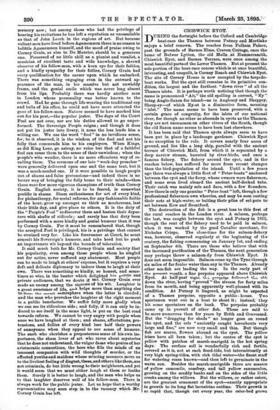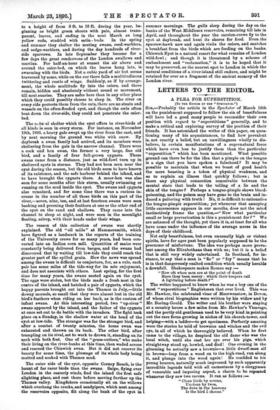CHISWICK EYOT.
DURING the fortnight before the Oxford and Cambridge boat-race the Thames between Putney and Mortlake enjoys a brief renown. The reaches from Pelham Palace, past the grounds of Barnes Elms, Craven Cottage, once the home of Bnlwer Lytton, the old Malls at Hammersmith, Chiswick Eyot, and Barnes Terrace, were once among the most beautiful parts of the Lower Thames. But at present the sole portion of the boat-race course which is at once beautiful, interesting, and unspoilt, is Corney Reach and Chiswick Eyot. The site of Corney House is now occupied by the torpedo- boat works. But the eyot still remains in its primitive con- dition, the largest and the furthest "down river" of all the Thames islets. It is perhaps worth noticing that though the name is pronounced "Ait," the old spelling is correct, "Ey " being Anglo-Saxon for island—as in Anglesey and Sheppey, Sheep-ey—of which Ey-ot is a diminutive form, meaning "islet." The name seems to have been preserved, with a certain grace of congruity, for the islets of our national river, for though no other so abounds in eyots as the Thames, they are not uncommon on other rivers of the South, though the old Saxon name seems to have been lost elsewhere.
It has been said that Thames eyots always seem to have been put in place by a landscape gardener. Chiswick Eyot is no exception to the rule. It covers nearly four acres of ground, and lies like a long ship, parallel with the ancient terrace of Chiswick Mall, from which it is separated by a deep narrow stream, haunted by river-birds, and once a famous fishery. The fishery around the eyot, and in the reaches below, has suffered far more from recent changes than the bird-population of the island. Until a few years ago there was always a little fleet of "Peter-boats" anchored between the eyot and the ferry, whose owners were fishermen, and some even lived aboard the ancient half-decked tubs. Their catch was mainly eels and dace, with a few flounders. Now there is only one genuine "Peter-boat "left, though a few professional fishermen own wherries, and may be seen casting their nets at high-water, or baiting their piles of eel-pots to set between Kew and Brentford.
The destruction of the fish is a great loss to this first of the rural reaches in the London river. A salmon, perhaps the last, was caught between the eyot and Putney in 1812, though the rent of the fishery used to be paid in salmon, when it was worked by the good Cavalier merchant, Sir Nicholas Crispe. The close-time for the salmon-fishery was, however, observed regularly at the beginning of the century, the fishing commencing on January 1st, and ending on September 4th. There are those who believe that with the increased purification of the Thames, the next generation may perhaps throw a salmon-fly from Chiswick Eyot. It does not seem impossible. Salmon come up the Tyne through six miles of far fouler water than any in the Thames. Already other sea-fish are leading the way. In the early part of +1,P seeeenk month, a fine porpoise appeared above Chiswick Eyot. At half-past elgea. 4:-Le Iteenoise fellemea down the river, having " proved " the stream for forty miles from its mouth, and being apparently well-pleased with its condition. At Putney it lingered, as might be expected of a Thames porpoise, opposite a public - house. Two sportsmen went out in a boat to shoot it ; instead, they hit some spectators on the bank. The porpoise probably came up in pursuit of other fish. These are said to be more numerous than for years by Erith and Gravesend. But the "dragging for shads" no longer goes on round the eyot, and the eels "anciently caught hereabouts very large and fine," are now very small and thin. But though fish are scarce, flowers abound on the eyot. The yellow irises have all been taken ; but the centre of the eyot is yellow with patches of marsh-marigold in the hot spring days. The surface soil is wonderfully rich and fertile, covered as it is, not at each flood-tide, but intermittently at very high spring-tides, with rich tidal water—the finest stuff for watering roses known—and then left to germinate in the warm sun. Besides the marsh-marigolds there are masses of yellow camomile, comfrey, and tall yellow rantuaculus, growing on the muddy banks and on the aides of the little creeks among the willows. But the willows, or rather osiers, are the greatest ornament of the eyot—exactly appropriate in growth to its long flat lacustrine outline. Their growth is so rapid that, though cut every year, the osier-bed grows
to a height of from 8 ft. to 10 ft. during the year, be- ginning as bright green shoots with pale, almost trans- parent, leaves, and ending in the next March as long yellow rods, studded with satin - buds. In the spring and summer they shelter the nesting swans, reed-warblers, and sedge-warblers, and during the day hundreds of river- side sparrows. In late September they become for a few days the great rendezvous of the London swallows and martins. For half-an-hour at sunset the air above and around the osier-bed, on which the leaves hang late, is swarming with the birds. Not a cubic yard of air but seems traversed by some, while on the ear there falls a multitudinous twittering and rustle of wings. Suddenly, as if by arrange- ment, the whole multitude fly into the osiers, and there remain, hidden and absolutely without sound or movement, till next sunrise. They are safer here than in any other place which they could possibly choose to sleep in. The river on every side protects them from the cats, there are no stoats and weasels on the often-flooded eyot, and though the owls often beat down the river-side, they could not penetrate the osier- bed.
The na tu sl shelter which the eyot offers to river-birds of all kinds is seen in every storm. For instance, on November 18th, 1893, a heavy gale swept up the river from the east, and by next morning the ground was white with snow. By daybreak a swan family had arrived, and its members were sheltering from the gale in the narrow channel. There were a cock and hen swan, the former a very large, fine old bird, and a family of four full-grown cygnets. These swans came from a distance, just as wild-fowl turn up in sheltered spots in storms. They had not been seen near the eyot during the season, but the old birds seem to have known -of its existence, and the safe harbour behind the is/and, and to have brought the cygnets there. A moor-hen was also seen for some months after this storm, usually swimming or running on the mud inside the eyot. The swans and cygnets also remained, and for some time there was a unions in- crease in the number of all these birds on this part of the river,— seven, nine, ten, and at last fourteen swans were seen basking and preening their feathers at one or the other end of the eyot on the sand and shallows. They came into the channel to sleep at night, and were seen in the moonlight floating, asleep, with their heads under their wings.
The reason of this collection of swans was shortly explained. The old "oil mills" at Hammersmith, which have figured as a landmark in the reports of the training of the University crews for so many years, had been con- verted into an Indian corn mill. Quantities of maize were constantly being delivered from barges, and the swans had discovered that by waiting till low-tide they could reach the greater part of the spilled grain. How the news was spread among the swans is difficult to conjecture, for, as a rule, each pair has some miles of the tide-way for its sole enjoyment, and does not associate with others. Last spring, for the first time for many years, the swans nested again on the eyot. The eggs were stolen, but the birds made a fresh nest in the centre of the island, and hatched a pair of cygnets, which the happy parents brought out into the Thames in July,—little downy morsels, so small that they were almost lost in the old bird's feathers when riding on her back, as is the custom of infant swans. At this interesting period, two " up-river " swans appeared by the island, and the father of the cygnets at once set out to do battle with the invaders. The fight took place on a Sunday, in the shallow water at the head of the eyot at low-tide. The stranger was far the stronger bird, and after a combat of twenty minutes, the home swan was exhausted and thrown on its back. The other bird, after trampling on its rival, set to work to drown it, standing on its neck with both feet. One of the "grass-cutters," who make their living on the river-banks at this time, then waded across and rescued the Chiswick swan. But it did not recover its beauty for some time, the plumage of its whole body being matted and soaked with Thames mud.
The outer side of the eyot, opposite Conley Reach, is the haunt of far rarer birds than the swans. Snipe, flying over London in the easterly winds, find the island the first safe alighting place, and rest there before moving further up the Thames valley. Kingfishers occasionally sit on the willows which overhang the creeks, and sandpipers, which nest among the reservoirs opposite, flit along the bank of the eyot in summer mornings. The gulls sleep during the day on the banks of the West Middlesex reservoirs, remaining till late in April, and throughout the year the carrion-crows fly to the eyot at daybreak, and hunt its shores for food. Even the sparrow-hawk now and again visits the osiers, and snatches a breakfast from the birds which are feeding on the banks. Chiswick Eyot is a natural resort for what remains of London wild-fowl ; and though it is threatened by a scheme of embankment and "reclamation," it is to be hoped that it may be preserved, as the nearest spot to London in which the natural conditions of a river-island still endure, and might be retained for ever as a fragment of the ancient scenery of the London river.







































 Previous page
Previous page